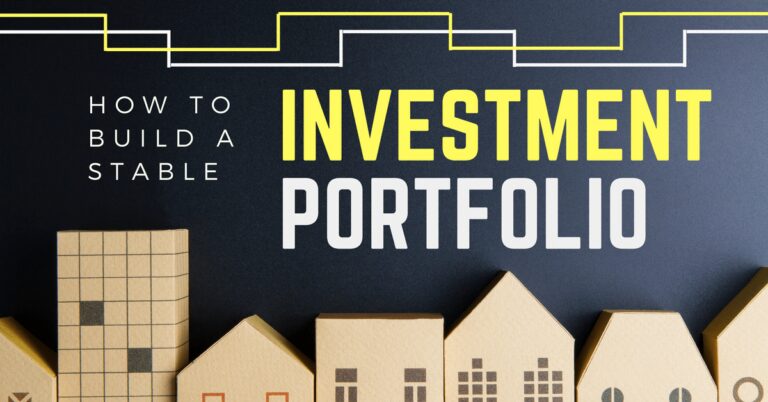A property portfolio consists of several buy to let investment properties that are owned by either a company, individual or a group of people.
By purchasing several properties, there is room to make a much higher return on your investment as opposed to just focusing on one specific property.
If one property is in a void period, for example, then you can still expect to make an income from the other properties in your portfolio.
The higher returns on investment have drawn an increasing number of investors interested in building a property portfolio.
Whether it’s through those looking to turn their buy to let investments into a full-time rental property business or a sole investor looking to own a sizeable amount of properties – it is important to know what you’re doing beforehand.
This guide will focus on five key tips to help you grow your property portfolio that will be of help to those at any stage of their investment journey – let’s dig in!
Financial Stability

First and foremost, those looking to secure a lucrative property portfolio need to ensure they understand the costs involved and have the right financial means to do so.
A collection of properties will be much more expensive than when investing in one specific property – so gaining a good grasp of the ongoing costs is essential.
At present, the average UK house price stands at £295,000 – which is following on from the fastest house price growth rate for over 15 years. As demand deepens, it may be tempting for would-be investors to dive into expanding their property portfolio.
Yet, with buy-to-let, there are various costs to consider which will be specifically heightened when undergoing several purchases.
These costs include stamp duty tax, letting agent fees, maintenance costs, ground rent, mortgage payments and income tax amongst others. Property investment companies like RWInvest can offer helpful guides to understand the costs involved.
Plan Long-Term

When planning a property portfolio, it is important to understand your long-term goals as this will inform the type of strategy you take.
It may be helpful to consider questions such as how quickly you want to see a return on your buy to let portfolio, if you’re looking to make your property portfolio a full-time career or if this is more of a retirement plan. In turn, it also worth planning long-term by considering how long you want to keep your buy to let portfolio for.
A long-term strategy will allow you to make the most informed decision which will in turn allow for the chance of a more lucrative rental return.
Focusing on residential properties in your portfolio may be wise for those looking to draw on growths over time – but If you’re looking for more short-term gains then investing in student accommodation may be a better option.
Location, Location, Location
When investing in any kind of property it is always worth seeking out the location that can deliver the highest rental returns.
In the UK specifically there is a huge disparity in growth potential, price and rental demand across different regions which makes investment in some parts of the country more desirable than others.
When looking at a specific area when building your portfolio why not consider factors such as the average cost of monthly rent, the demographic makeup of the area, house price growth potential and rental yields.
These factors will point to areas that offer more potential for a successful investment portfolio – areas like Liverpool and Manchester have become popular destinations for investor portfolios due to the thriving rental market in such cities, for example.
Consider Your Tenants

Putting your tenants first and maintaining a strong positive relationship will be of upmost importance as it is more likely they will stay long-term which lessens the chances of void periods.
It may be easy to succumb to property marketing and seeing your portfolio as just another investment asset – but focusing on your target tenant will be just as important.
Depending on age demographics, the needs of certain tenants are constantly shifting – for example, young professionals are now more likely to have a job where they work from home. This means certain properties should try and accommodate these needs by ensuring there are facilities like fast broadband on hand.
New builds have also increasingly grown in demand so the type of property you want to invest in should also be defined by the needs of the market as this is more likely to make the properties in your portfolio stand out.
Diversify The Portfolio

In adopting a flexible, diverse investment strategy you are opening yourself up for greater gains to your property portfolio.
Instead of solely investing in student accommodation in the same area, for example, it may be worth adopting other buy to let strategies such as single let residential property or commercial buy to let as you can make gains on these when other types slow down.
By choosing a different type of property, such as flats and houses, as well as diversifying the area you invest in, you will be able to draw higher rental returns.
Conclusion
Overall, planning a property portfolio is a task that will require a lot of planning and expertise – however, this should not put people off as the potential to make a high rate of return under a set of investment opportunities will ultimately pay off.
Maintaining a good grasp on your wants, needs and expectations for your portfolio will be of the upmost importance. By considering the above tips you can gain greater confidence in your investment journey. For further clarity, it may be worth speaking to a financial advisor who can help you understand the best investment strategy for you.
Related Posts:
- 20 Best Gaming Headset Under 50$ 2024 - for PC, PS4,…
- Exploring Mortgage Note Portfolios: An Overview of…
- Top 10 Best Modem For Gaming 2024 - For Optimum Gaming Speed
- Top 10 Best Office Chair Under 200 2024 - Ergonomic…
- Passive Income Myths Debunked: Separating Fact from Fiction
- 26 Unique 25th Anniversary Return Gifts To Show Your…







